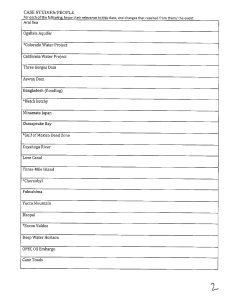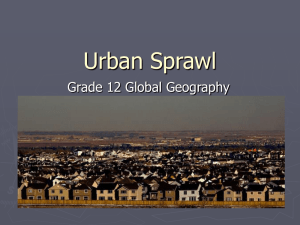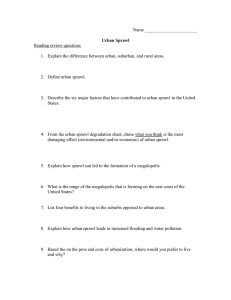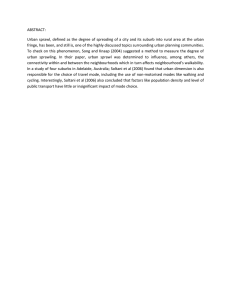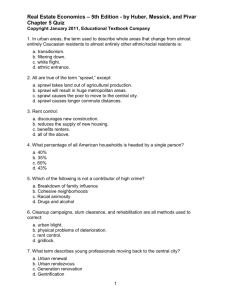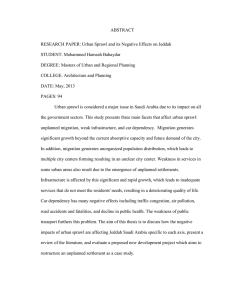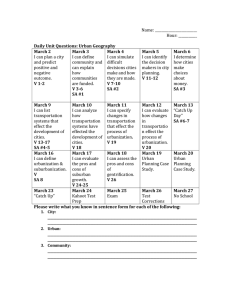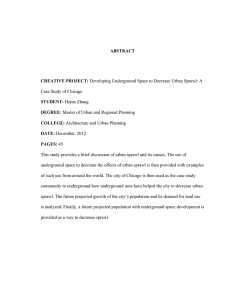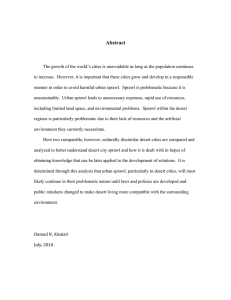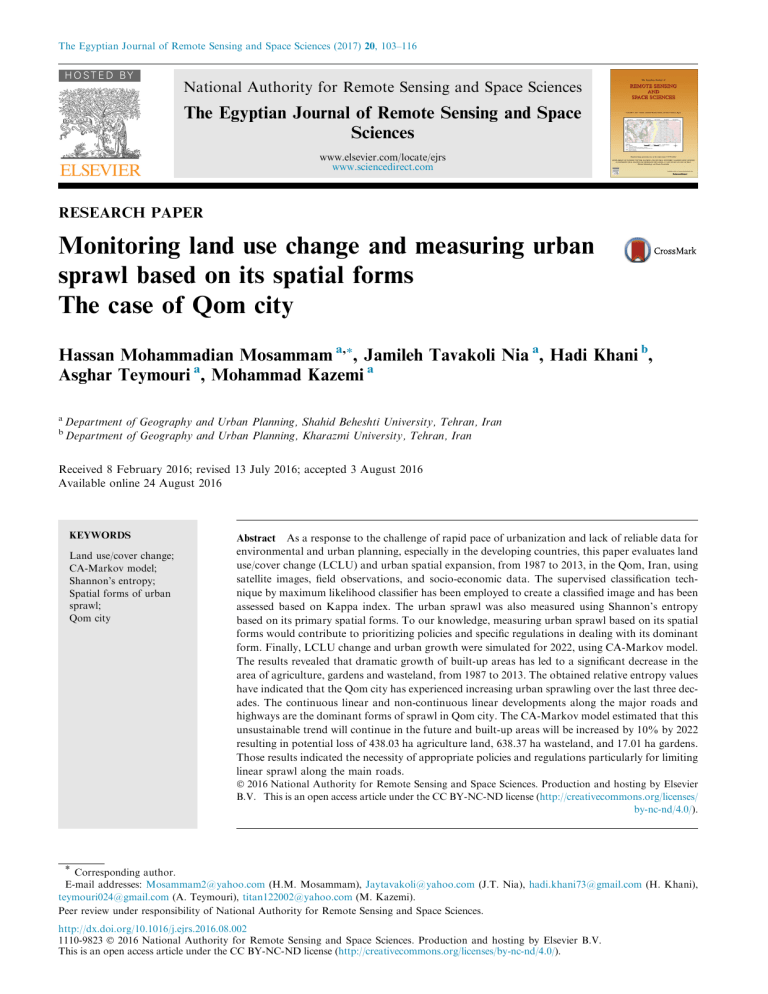
The Egyptian Journal of Remote Sensing and Space Sciences (2017) 20, 103–116 H O S T E D BY National Authority for Remote Sensing and Space Sciences The Egyptian Journal of Remote Sensing and Space Sciences www.elsevier.com/locate/ejrs www.sciencedirect.com RESEARCH PAPER Monitoring land use change and measuring urban sprawl based on its spatial forms The case of Qom city Hassan Mohammadian Mosammam a,*, Jamileh Tavakoli Nia a, Hadi Khani b, Asghar Teymouri a, Mohammad Kazemi a a b Department of Geography and Urban Planning, Shahid Beheshti University, Tehran, Iran Department of Geography and Urban Planning, Kharazmi University, Tehran, Iran Received 8 February 2016; revised 13 July 2016; accepted 3 August 2016 Available online 24 August 2016 KEYWORDS Land use/cover change; CA-Markov model; Shannon’s entropy; Spatial forms of urban sprawl; Qom city Abstract As a response to the challenge of rapid pace of urbanization and lack of reliable data for environmental and urban planning, especially in the developing countries, this paper evaluates land use/cover change (LCLU) and urban spatial expansion, from 1987 to 2013, in the Qom, Iran, using satellite images, field observations, and socio-economic data. The supervised classification technique by maximum likelihood classifier has been employed to create a classified image and has been assessed based on Kappa index. The urban sprawl was also measured using Shannon’s entropy based on its primary spatial forms. To our knowledge, measuring urban sprawl based on its spatial forms would contribute to prioritizing policies and specific regulations in dealing with its dominant form. Finally, LCLU change and urban growth were simulated for 2022, using CA-Markov model. The results revealed that dramatic growth of built-up areas has led to a significant decrease in the area of agriculture, gardens and wasteland, from 1987 to 2013. The obtained relative entropy values have indicated that the Qom city has experienced increasing urban sprawling over the last three decades. The continuous linear and non-continuous linear developments along the major roads and highways are the dominant forms of sprawl in Qom city. The CA-Markov model estimated that this unsustainable trend will continue in the future and built-up areas will be increased by 10% by 2022 resulting in potential loss of 438.03 ha agriculture land, 638.37 ha wasteland, and 17.01 ha gardens. Those results indicated the necessity of appropriate policies and regulations particularly for limiting linear sprawl along the main roads. Ó 2016 National Authority for Remote Sensing and Space Sciences. Production and hosting by Elsevier B.V. This is an open access article under the CC BY-NC-ND license (http://creativecommons.org/licenses/ by-nc-nd/4.0/). * Corresponding author. E-mail addresses: Mosammam2@yahoo.com (H.M. Mosammam), Jaytavakoli@yahoo.com (J.T. Nia), hadi.khani73@gmail.com (H. Khani), teymouri024@gmail.com (A. Teymouri), titan122002@yahoo.com (M. Kazemi). Peer review under responsibility of National Authority for Remote Sensing and Space Sciences. http://dx.doi.org/10.1016/j.ejrs.2016.08.002 1110-9823 Ó 2016 National Authority for Remote Sensing and Space Sciences. Production and hosting by Elsevier B.V. This is an open access article under the CC BY-NC-ND license (http://creativecommons.org/licenses/by-nc-nd/4.0/). 104 1. Introduction The rapid pace of world’s urban population growth, especially in developing countries, is one of the major challenges for governments and planning agencies. Today, 3.9 billion people—54 percent of the world’s population—reside in urban areas and is expected to reach 6.3 billion in 2050, with nearly 90 percent of the future urban population increase being in developing world cities (United Nations, 2015). Without any doubt, this trend has been the considerable spatial manifestation and will continue in future. The inevitable outcomes from this process are the spatial expansion of towns and cities beyond their juridical limits and into their hinterlands and peripheries in order to accommodate the growing urban population. In this condition, we will need to adapt to this process. Therefore, effective governance and planning to achieve a more sustainable urban form are crucial for urban planners and policy makers. In other words, urban areas and their spatial extension are needed to minimize wasteful use of non-renewable resources, to avoid the disruption of the ecosystem equilibrium, to reduce social inequities, and to promote inclusive and sustainable development (Burgess and Jenks, 2002; UNHabitat, 2008). However, since World War II, urban sprawl has gradually become one of the dominant urban spatial expansion patterns throughout the world, with the differences in dates, causes, and consequences (Ewing et al., 2003a; Gill, 2008; EEA, 2006; Gómez-Antonio et al., 2014). The literature review indicated that there is no clear-cut consensus on the definition of urban sprawl which is strongly dependent on the cultural, geographic and political context’ (see Torrens, 2008; Besussi et al., 2010). In general, urban sprawl refers to certain forms of city spatial expansion toward suburbs and peripheral areas with, low density, single-use, extensive road and highway networks, car-dependent, open up vast space of territory, scattered and ribbon development in an mono-centric urban structure. (Ewing, 1997; Galster et al., 2001; Hasse and Lathrop, 2003; Zhang, 2001; Tewolde and Cabral, 2011; GómezAntonio et al., 2014). In developed countries, it has been fueled by globalization, market economy and dominance of capitalism ideology, particularly in automobile industry and fuel market, as well as reduced livability of inner-city, ( Ewing, 1997; Snyder and Bird, 1998; Galster et al., 2001; Besussi et al., 2010); in developing countries, it is often the result of overtaking of urbanization from urban planning, inappropriate government’s land and housing policies, urban–rural migrations and low and middle-income household’s efforts to find an affordable housing in the urban fringe (see Deng and Huang, 2004; Menon, 2004a,b). However, a major concern with the urban sprawl and LULC change is associated with negative environmental, social and economic impacts (Buiton, 1994; EEA, 2006; Hasse and Lathrop, 2003). The environmental dimension impacts include the loss of fertile lands, open space and biodiversity ( Harris, 1984; Benfield et al., 1999; McKinney, 2002; Atu et al., 2013) spoiling water quality (Allen and Lu, 2003; Wilson et al., 2003; Tu et al., 2007), higher GHG emissions and pollutions levels (Glaeser and Kahn, 2004) and increasing runoff and flood potential, and increase of energy consumption. (EEA, 2006; Sung et al., 2013) In the socio-economic dimension urban sprawl leads to excessive infrastructure and public service costs (Lee et al., 1998; Burchell and Listokin, 1995; Batty, 2008) the decline H.M. Mosammam et al. of downtown and public space, reducing social cohesion, loss of a sense of community, reducing public health, safety and security, loss of cultural values (Freeman, 2001; Nechyba and Walsh, 2004; EEA, 2006; Resnik, 2010; Jaeger et al., 2010; Pereira et al., 2014), increase of income inequality and polarization (Carruthers and Ulfarsson, 2003; Brueckner and Helsley, 2011) traffic congestion (Ewing et al., 2003b; Hathout, 2002) longer travel distance and limited access, especially for non-driver people. (Ewing, 1997; Kain, 1992; Bento et al., 2003). Over the last few decades, the exacerbation of these issues not only has led to rising new approaches to achieving a more sustainable urban form such as smart growth and compact city (Ewing, 1997; Kushner, 2002; Shaw, 2000; Jenks and Dempsey, 2005), but also new methods and techniques have been developed to monitor and analyze urban sprawl phenomenon and its consequences. In an effort to monitor and analyze urban sprawl, some research organizations and researchers (Peiser, 1989; Sierra Club, 1998; El Nasser and Overberg, 2001; Galster et al., 2001; Ewing et al., 2003a) measure urban sprawl by their indicators, while other scholars emphasize the spatial and temporal technologies such as GIS and remote sensing in combination with statistical techniques (Clarke and Gaydos, 1998; Galster et al., 2001; Yeh and Xia, 2001; Hasse and Lathrop, 2003; Thomas et al., 2003; Ji et al., 2006; Jat et al., 2008a; Dewan and Yamaguchi, 2009; Tewolde and Cabral, 2011; Rawat et al., 2013; Deep and Saklani, 2014; Alexakis et al., 2014; Liu and Yang, 2015). However, the mapping and monitoring of urban sprawl and LULC changes using GIS and remote sensing techniques has attracted more interests and has largely proved to be effective and valuable tools for monitoring and estimating urban sprawl over a time period (Yeh and Li, 1997; Masser, 2001; Jat et al., 2008b; Belal and Moghanm, 2011; Butt et al., 2015; Dadras et al., 2015). Those tools are also effective in cost and time related barriers (Epsteln et al., 2002; Haack and Rafter, 2006). Beyond methods, investigation and monitoring of urban growth and LULC change are necessary to examine the impacts and identifying the points of intervention and to direct growth away from sensitive ecological areas, especially in developing countries. Like most of the developing countries, Iran has experienced high urban population growth in the last five decades. The number of cities has increased substantially from 199 in 1956 to 1139 in 2011, and the urban population has grown about nine times in the same period (Statistical Center of Iran, 2011). According to Statistical Center of Iran, more than 71.4 percent of the Iran’s population – 53.646.661 people – living in towns and cities in 2011. In Iran, urbanization growth has been fueled by governments’ incentives and policies particularly after Islamic Revolution and disparity in regional development which resulted in urban–rural migrations. One of the major consequences of this trend has been the urban sprawl over the last few decades (Shahraki et al., 2011; Roshan et al., 2010; Arsanjani et al., 2013; Dadras et al., 2014; Mohammady, 2014; Ebrahimpour-Masoumi, 2012). Since the big cities and metropolitans in Iran are situated at the heart of fertile agricultural regions, understanding and monitoring the urban growth and LULC change is crucial and would be helpful for the city planners and policy makers to direct future developments and for environmental management (Sudhira et al., 2004; Knox, 1993; Simmons, 2007). Monitoring land use change and measuring urban sprawl in Qom city Accordingly, this paper aimed to indicate and monitor urban spatial expansion patterns and land use change in the Qom city based on spatial forms of urban sprawl. Also, future directions and growth patterns of the city by 2022 are estimated. 2. Materials and methods 2.1. Setting The study has focused on the land use changes and sprawl analysis of Qom city. Geographically the city is located in between 34°260 4900 and 34°470 4100 North latitudes and 50°410 1000 and 51°230 400 East longitude. Qom city situated in the arid region and annual rainfall average is 161 mm (IRIMO, 2006). It’s characterized by limited access to arable land and water resources. Qom city, as a center of Qom province and county and the second holy city of Iran (after Mashad), has been experienced rapid pace of population growth over last six decades, from 96,499 people in 1957 to more than 1.08 million in 2011 (Statistical Center of Iran, 1956, 2011; AMCO Consulting Engineers, 2003). It’s also the destination of international migrants largely from Iraq and Afghanistan (Statistical Center of Iran, 2011). The city has been selected as a case study because has been experienced rapid spatial expansion into its peripheries and includes a diversity of LULC classes. In addition, on average, there are 246 sunny days per year in Qom (IRIMO, 2006). Hence this city has been viewed as an ideal test-bed area for the classification. Analyzing these trends and employing an advanced approach to predict changes in LULC may provide valuable information for policy-makers and urban planners. Figure 1 105 Like other Iran’s cities, Qom has two boundaries namely; legal/official city boundary and authority boundary. The legal/official city boundary is the main urban area being under the control of the Qom municipal where urban services and facilities are provided by the municipality. The authority boundary (or Harime Shahr) is identified outside the official city boundary and preserved for future urban growth. Although in this boundary urban development is limited and any residential development considered as illegal, there are many informal settlements and other construction such as small scale manufacturing. In this paper all LULC and spatial forms of urban sprawl statistics were calculated based on authority boundary. However, Shannon’s entropy analysis was based on legal city boundary. The total area of Qom’s authority boundary is about 34850 ha. The legal/official Qom boundary has been divided into 8 districts (Bavand Consultant Engineers, 2013). Fig. 1 represents an overview of Qom and the city’s geographic locations, boundaries as well as administrative districts (Fig. 2). 2.2. Data sets Landsat TM satellite images for the years 1987, 1999, and 2013 were obtained from United States Geology Survey (USGS) and were utilized in this paper. Detailed information about the remotely sensed images is listed in Table 1. In image acquisition, we have considered to the impacts of Sun’s inclination, season and cloud cover. In supporting the study, secondary data were obtained from the different Qom’s organizations. The City boundaries map, districts shape file and land use maps were obtained from Qom municipality and General Bureau of Road & Urban Development of Location map of the study area and Qom city districts. 106 Table 1 H.M. Mosammam et al. Detailed information of utilized satellites imagery (Source: US Geological Survey, 2013). Satellites Acquisition date (Dar/Month/Year) Sensor Spatial resolution Projection True color composite (TCC) Landsat 8 Landsat 5 Landsat 5 10/18/2013 8/9/1999 8/24/1987 OLI_TIRS TM TM 30 m 30 m 30 m WGS84 UTM Zone 39 N WGS84 UTM Zone 39 N WGS84 UTM Zone 39 N BAND 7, 5, 3 BAND 7, 4, 1 BAND 7, 4, 1 Qom Province. (Bavand Consultant Engineers, 2013; EMCO IRAN Consultant Engineers, 2003). The demographic details were obtained from Iran’s Census Center and Qom municipality. In addition, the region’s aerial photographs were acquired from National Cartographic Center of Iran (NCC). We also have conducted fields’ observations in study area as a basis for accuracy assessment. 2.3. Image pre-processing and classification The atmospheric correction is a necessary step to accurately extract quantitative information from the Landsat (Liang et al., 2001). To image pre-processing, Landsat 8 OLI image rescaled to the Top of Atmosphere (TOA) reflectance and/or radiance using the standard Landsat equations and scaling factors (United States Geological Survey, 2015). Then, Dark Object Subtraction (DOS) was used for atmospheric correction. The atmospheric correction of Land sat 5 imageries was conducted using QUick Atmospheric Correction (QUAC) in the ENVI 5.1. The supervised classification by IDRISI Selva was employed to process and classify of the images of the case study. The reference data include aerial photographs, land use maps were used to assist in supervised training site selection for LULC features of interest. It also supplemented by field observations. Based on different bands of the Landsat images a composite image was created that helps us to clear distinguish the different LULCs in images. We included at least 100 pixels in each individual training sites that are created by digitizing polygons. Based on identified training sites, the signature file is created for each land cover class using the signature development tool MAKESIG. The maximum likelihood classifier (MLC) was used for spectral classification of the land sat images based on the training sites (signatures), at a 30 m resolution and a projection system (UTM-WGS 1984 Zone 39 N). The five land cover classes were identified in the study area, namely, built up area, agricultural land, wastelands, gardens, and rocky outcrop (Table 2). Afterward, post-classification refinements were used to reduce classification errors created by the similarities in spectral responses of individual classes. Additionally, a normalized spectral mixture analysis (Wu, 2004) was applied to address the problem of mixed pixels (Lu and Weng, 2005) After image classification, mode filter (5 5) was used to each classification to generalize the supervised classified LULC images and remove the isolated pixels Table 2 (Lillesand and Kiefer, 1999). Finally, the generalized images are reclassified to create the final version of LULC maps for 1987, 1999 and 2013. 2.4. Classification accuracy assessment Accuracy assessment for individual classification is essential to correct and efficient analysis of LULC change (Butt et al., 2015). It indicates the degree of deference between classified images and reference data. Thus, to determine the quality of information extracted from the data, classification accuracy of 1987, 1999 and 2013 images was analyzed. An independent sample was chosen from the ground or reference data and sample size for each class was 30 (Congalton and Green, 1999). Based on error matrix (Congalton and Green, 1999: 34–64) the accuracy assessment of LULC maps was carried out. The error matrix compares the relationship between known ground or reference data and the corresponding outcomes of an automated classification. In this paper, some of the accuracy statistics namely; the overall accuracy (OA), user’s accuracy (UA), producer’s accuracy (PA), and Kappa Index of Agreement (KIA) as accuracy statistics were derived from the error matrices to assess the classification accuracies (Congalton and Green, 1999). 2.5. Change detection The post-classification method is one of the most common methods to change detection (Jensen, 2004). In this study, this method was used to determine changes in LULC in three intervals (i.e. 1987–1999, 1999–2013, and 1987–2013). Pixel-bypixel cross tabulation analysis was applied to determine the quantity of conversions from a particular LULC class to other LULC categories. 2.6. Urban sprawl measurement It is necessary to prove occurrence of this phenomena in Qom city prior to measuring urban sprawl based on its spatial forms. Thus, urban sprawl over the period of 1987 to 2013 was determined using Shannon’s entropy along with GIS tools. Shannon’s entropy is one of the commonly used and effective technique for monitoring and measuring of urban sprawl (Yeh Identified classes by supervises classification. NO. Land classes Description 1 2 3 4 5 Built-up Agriculture land Wasteland Gardens Rocky outcrop Residential, Commercial, Industrial, Roads, Railway, mixed urban or build-up land Crop land, Fallow land Salt affected land, waterlogged land Forests, Vineyards, Parks, Orchards, Groves, Nurseries Barren rocky/stony, Mountain, Barren hill Monitoring land use change and measuring urban sprawl in Qom city and Xia, 2001; Jat et al., 2008a; Sarvestani et al., 2011; Punia and Singh, 2012). It has been used to measure the degree of compactness and dispersion of a geophysical variable (city lands) among ‘n’ spatial units (Theil, 1967; Thomas, 1981). Shannon’s entropy is calculated by the following equation (Yeh and Xia, 2001): Hn ¼ n X Pi Logð1=Pi Þ i where: pi is the probability or proportion of the variable occurring in the ith districts and n is the total number of districts or zones. We have used relative entropy for scale the entropy value from 0 to 1. The relative entropy is calculated by following equation (Thomas, 1981): Hn ¼ n X Pi Logð1=Pi Þ= logðnÞ i The Shannon’s entropy values are different between 0 and LogðnÞ. The value closer to zero means compact urban growth (higher density), while values closer to ‘log n’ indicates dispersed distribution of city’s built environment (Yeh and Xia, 2001). After measuring urban sprawl, we have analyzed spatial forms of sprawl in Qom. 2.7. Urban land use change modeling using CA-Markov 107 elevation, barren areas, population density, and distance to the road are selected to create transition potential maps of LULC. Transition suitability maps were generated based on certain weights for those factors (Saaty, 2003). The suitability map values was standardized from 0 to 255 as the CA transition parameters, with higher values indicating more suitability (Poska et al., 2008). In the third stage, a standard 5 5 contiguity filter was employed to determine the CA filter to define the neighborhood in this study (Sang et al., 2011). For model validation, the predicted map of 2013 was used as the comparison input in the validation module, and the classified image of 2013 was the reference input. The accuracy of the predicted 2013 LULC map was assessed using the VALIDATE module in IDRISI to estimate the level of agreement with the LULC map of 2013 based on three Kappa indices of agreement namely: Kno, Kstandard, and Klocality (Pontius, 2000; Mitsova et al., 2011). Using the all Kappa indexes for the assessment not only determine the overall success rate but also provide an understanding of the effective factors in the strength or weakness of the results (Geri et al., 2011). For perfect agreement, Kappa equals 1, while a value of 0 indicates the agreement is exactly by chance (Pontius, 2000). Finally, the number of iterations was determined. We took the 2013 LULC map as the base point and selected 18 CA iterations to model the predicted LULC in Qom in 2022. Figure 2 represents the research process. 2.7.1. CA-Markov model and validation LULC simulation involves measuring LULC changes between t1 and t2 and extrapolating these changes intofuture (Eastman, 2009). CA-Markov Model is one of the most common modeling methods that many researchers have proven the efficiency of the model for simulating urban growth (White and Engelen, 1997; de Noronha et al., 2012). The Markov Chain Model is a stochastic progression that analyzes the probability of LULC change over the times period by developing a transition probability matrix ( Eastman, 2006; Sun et al., 2007; Muller and Middleton, 1994; López et al., 2001). The output of Markov Chain analysis is a transition probability matrix between t1 and t2 that indicates the probability of LULC change from one period to another. However, lack of the spatial dimension is one of the major limitation of Markov and it cannot identify spatial distribution of occurrences within each LULC category (Eastman, 2003; Ye and Bai, 2008). The Cellular Automata (CA) methods are very efficient tools for imitating complex spatial processes based on simple decision rules (Wolfram, 1984). Each cell has a certain condition or function that is influenced by its neighboring cells as well as features of the cell itself (Eric et al., 2007). CA- Markov chain is a combination of Markov Chains and Cellular Automata that was developed to solve Markov chain limitation through adding a spatial dimension to the model by Cellular Automata. CA-Markov model in IDRISI Selva was used for LULC modeling and simulation in Qom city. In this study, simulating future LULC change and urban growth using a CA-Markov model occurred in several steps. In the first step, LULC maps for the years 1987, 1999, and 2013 resulting from the supervised classification were applied to measure transition probability matrices of LULC classes between 1987 and 1999, and 1999 and 2013 using Markov model. In the second step, transition matrix probabilities were employed in simulation of future LULC changes. Step 2 was to create suitability maps and some indicators including 3. Results and discussion 3.1. Classification accuracy assessment Error matrices were employed to assess classification accuracies and are detailed for all three years in Tables 3–5 using maximum likelihood classifier as the classification method. The overall accuracy indicates the percentage of correctly classified pixels. The overall accuracies of the classification methods for 1986, 1999, and 2013 ranged from 91.39% to 98.30%, with Kappa coefficients from 76% to 96%. According to Anderson (1976), 85%, as a minimum accuracy value is acceptable. Hence, the accuracy assessment is reliable. The producer’s and user’s accuracy for three years are found ranging from 50.16% to 100% (Tables 3–5). 3.2. Land use/cover change The analysis of LULC changes based on post-classification change detection and landscape metrics has revealed that in the first period, from 1987 to 1999, the built-up area has increased by greater than 1997 ha that is more than 36 percent (Table 6). In other words, it can be observed from Table 6 that in 1987 the built-up area was 5453.73 ha, 15.6% of the study area while the agriculture land covered 8333.91 ha, 23.91% of the study area. The land cover map of 1999, however, shows that the built-up area was 7450.74 ha, about 21.37% of the study area, an increase of 36.47% compared to 1987 (Table 6). The agriculture land had reduced to 8186.04 ha, a reduction about 2% (Table 6). In contrary to agriculture land, the wasteland area and gardens have increased tremendously, from 315.54 ha, and 60.03 ha in 1987 to 484.74 ha, 119.52 ha in 1999, respectively (Table 6). 108 H.M. Mosammam et al. Data source Thematic Data - Aerial Photographs - Land use - Major Roads Map - Detailed Plan Landsat TM Images (1986, 1999,2013) Thoposheets Image Pre Processing Supervised Classification Training Data Collection No Classification : Maximum likelihood Accuracy Assessment : Error Matrix , Kappa Coefficient Land Use/Cover Map Modeling the Urban Growth Yes Urban Sprawl Measurement Markov Analysis Transition Area Matrix and Transition Probability Matrix 1999-2013) Transition Area Matrix and Transition Probability Matrix (1986 to 1999) Shannon's Entropy No Analyzing Urban Spatial Forms Simulated Map 2013 CA Model Actual map 2013 Kappa Index Validation Yes Caliberated CA -Markov Model Land Use Map 2022 Figure 2 Research flowchart. During the second decade, 1999 to 2013, the built up area kept the pace of growth and gained 2713 ha (Table 6). Unpredictably, agriculture land and gardens decreased by about 39%, 9.2%, respectively (Table 6). The greatest reduction in this period is related to wastelands that have been shrunk about eleven times. Table 7 indicates that more than 1461 ha of agriculture land and 23 ha gardens have converted to the built-up area, from 1987 to 2013. Urban sprawl has occurred mainly in the rocky outcrop and 3187 ha of this land cover converted to built up area. The built up area not only has led to fragmentation of agriculture land (Fig. 3) and results in the decrease of productivity, but also threatens urban food security, local food and economy (De Zeeuw et al., 2007; FAO IFAD and WFP, 2005). Monitoring land use change and measuring urban sprawl in Qom city Table 3 109 Error Matrix (%) comparing the image classification of 1987 to the reference data. Classes 1 2 1 2 3 4 5 Column total Producer’s Accuracy (%) Overall accuracy 2184 1 0 0 54 2239 97.38 98.30 8 30 5148 18 0 323 0 0 57 267 5213 638 98.55 50.16 Overall Kappa 3 4 5 Row total User’s accuracy (%) 8 0 0 101 36 145 69.57 92 30 28 0 28,717 28,867 97.58 95% 2322 5197 351 101 29,131 37,102 93.68 98.9 91.89 100 93.58 Class legend: (1) Built-up, (2) Agriculture land, (3) Wasteland, (4) Gardens, (5) Rocky outcrop. Table 4 Error Matrix (%) comparing the image classification of 1999 to the reference data. Classes 1 2 1 2 3 4 5 Column total Producer’s Accuracy(%) Overall accuracy 2239 0 0 0 0 2239 100 98.47 8 36 5106 16 1 358 0 0 98 228 5213 638 97.62 55.68 Overall Kappa 3 4 5 Row total User’s accuracy (%) 8 1 0 136 0 145 93.77 133 31 7 0 28,696 28,867 97.28 96% 2424 5154 366 136 29,022 37,102 91.88 98.92 97.78 100 94.94 Class legend: (1) Built-up, (2) Agriculture land, (3) Wasteland, (4) Gardens, (5) Rocky outcrop. Table 5 Error Matrix (%) comparing the image classification of 2013 to the reference data. Classes 1 2 1 2 3 4 5 Column total Producer’s Accuracy (%) Overall accuracy 2239 0 0 0 0 2239 100 91.39 385 37 3624 13 0 96 0 0 1204 492 5213 638 65.78 14.83 Overall Kappa 3 4 5 Row total User’s accuracy (%) 8 0 0 135 2 145 93.08 636 417 0 0 27,814 28,867 82.17 76% 3305 4054 96 135 29,512 37,102 65.67 87.66 100 100 74.08 Class legend: (1) Built-up, (2) Agriculture land, (3) Wasteland, (4) Gardens, (5) Rocky outcrop. Table 6 Land use/cover statistics of the Qom City; in 1986, in 1999, in 2013. Land Class 1987 1999 Area (ha) Area (%) Area (ha) Area (%) Area (ha) Area (%) Built-up Agriculture land Wasteland Gardens Rocky outcrop Total 5453.73 8333.91 315.54 60.03 20686.5 34849.71 15.64 23.91 0.901 0.17 59.35 100 7450.74 8186.04 484.74 119.52 18608.67 34849.71 21.37 23.48 1.39 0.34 53.39 100 10163.79 5032.62 45.72 108.45 19,499 34849.71 29.16 14.44 0.13 0.31 55.95 100 However, Iran is faced with many climate change impacts (IRIMO, 2006; Mosammam et al., 2016) and increased agriculture imports have led to one of the world’s largest markets for crops imports (Ministry of Agriculture Jihad, 2015). It is worth mentioning that, from 1987 to 2013, new technology has 2013 greatly increased the use of underground water and has led to the development of irrigated agricultural land in Iran (Ministry of Agriculture Jihad, 2015). Qom is no exception and 3800 ha rocky outcrop and wasteland has been converted to agriculture land by using groundwater over the last three 110 Table 7 H.M. Mosammam et al. Land use/cover change conversation statistics by classes from 1987 to 2013. LULC changes 1987–1999 Agricultural land to Built up area Waste Lands to Built up area Gardens to Built up area Rocky outcrop to Built up area Total Figure 3 Area (%) Area (ha) Area (%) 595.62 13.68 11.7 1376.01 1997.01 29.83 0.69 0.59 68.90 100 865.71 55.44 11.34 1780.56 2713.05 31.91 2.04 0.42 65.63 100 Urban land cover changes between 1986 and 2013. decades. However, like other regions of Iran climate change impacts, excessive use of groundwater and significant reduction of precipitation and groundwater aquifers in Qom has led to loss of 5029 ha of irrigated agricultural land over the last three decades (AMCO Consulting Engineers, 2003). 3.3. Urban sprawl in Qom The Shannon’s entropy (Hn ) was computed for Qom city builtup area to analyze the level of dispersion or compactness of the Table 8 1999–2013 Area (ha) spatial expansion of the city. The buffer function of a GIS has been used to define zones from the center of downtown along with density data. In this paper, 17 spatial units (zones) with a radius of a ø mile covered all of the legal city boundaries of Qom. The highest value of Shannon’s entropy [Loge (17)] is 2.833. Total Shannon’s entropy results for 3 years (1986, 1999, and 2013) have been presented in Table 8. The entropy results obtained for the three study periods are 2.281, 2.366, and 2.511 respectively. Similarly, lower value of relative Shannon’s entropy (0.805) is in the year 1986 and largest value Shannon’s entropy values for three years in the study area. Year Built up area Value of Shannon’s entropy Value of relative Shannon’s entropy 1987 1999 2013 Log (17) 5457.87 7455.42 10175.13 2.833 2.281 2.366 2.511 – 0.805 0.835 0.886 – Monitoring land use change and measuring urban sprawl in Qom city Figure 4 111 Density of Qom in 2008, 2013. (0.886) is in the year 2013 (the maximum is 1). Those values are larger than half of the Loge (17), it can be argued that this city is sprawled (Bhatta et al., 2009). In other words, the entropy values reveal that there was less urban sprawl in the year 1986 and it started to increase in 1999 and 2013. It indicates that at the time of 1986 Qom city was more compact compared to 1999 and 2013. City density patterns in Qom districts were also examined to clearer ascertain whether the different zones have represented different densities (Fig. 4). As you can see, new development area has lower density and result in negative ecological, economic and social impacts on the city (Mumford and Copeland, 1961; Munda, 2006). 3.4. The spatial forms of urban sprawl By inspiration from the major spatial form of urban sprawl (Galster et al., 2001; Besussi et al., 2010) and using ø mile buffer zone from main roads and highways, the forms of urban sprawl were analyzed in the authority boundaries of Qom city. The built area of Qom city for the year 1956 was based on reference data and built area for 1987, 1999, and 2013 was obtained from spatiotemporal analysis of Landsat images. We also considered the date of new road constrictions to distinguish sprawl form (Bavand Consultant Engineers, 2013; EMCO IRAN Consultant Engineers, 2003). The results revealed that Qom city has four major spatial forms of sprawl namely low density continuous, continuous linear, noncontinuous linear, and leapfrog (Fig. 5). There is more spread of land development in the continuous linear, and noncontinuous forms. The continuous linear form is the dominant form of sprawl in Qom city and accounts for more than 2470 ha land development spread over the urban fringe. This form has led to loss of more than 921 ha agriculture land, 8 h gardens from 1987 to 2013 (Table 9). The second form is non-continuous linear form. This form is similar to continuous linear and developed along the primary roads but is separated from the continuous city growth. The form is responsible for 1027 ha land development and has led to the conversion of 52 ha agriculture land to a built up area from 1987 to 2013 (Table 9). It’s also the primary form in terms of conversion of gardens to built up area. During the first period, from 1987 to 1999, leapfrog development was higher compared to the second period, from 1999 to 2013 (Table 9. Fig. 6). In contrast, in the first period, the continuous and non-continuous linear and low density continuous forms were lower than the second period. The major roads which stimulate the linear development are the Persian Gulf and Imam Ali highways, Amir Kabir and QomGasgmar freeways, Al Ghadir boulevard and, Qom-Kashan roads (Fig. 5). The third form of sprawl is low-density continuous that accounts for 933 ha land development during 1987 to 2013. This form has led to the destruction of more than 3706 ha agricultural land in the same period (Table 9). The leapfrog development has a very small share in the land use change. The situation of the Qom in the connection path of the two main cities of Iran (Tehran in north and Isfahan in south) and lacking fertile land and water resources in urban fringes and hinterland are major factors in the dominance of linear forms. Unlike American cities in which favorable climate and favorable lands in the urban fringes are the main factors in suburbanization and scattered development, in Iran often water scarcity in desert regions has limited suburbanization and leapfrog development of cities. 3.5. Land cover modeling and validation LULC maps in 1986 and 1999 were defined as input data to simulate 2013 land-use. However, model validation is an essential stage of any simulation of LULC change to compare the simulated and reference map. The comparisons between the 112 H.M. Mosammam et al. Figure 5 Table 9 Spatial form of sprawl in Qom, 1987, 1999, 2013. Spatial forms of urban sprawl Area (ha). Transition of land classes to built-up Agricultural land to Built up area Gardens to Built up area Wastelands to Built up area Rocky outcrop to Built up area Total Leapfrog Development Noncontiguous Linear Continuous Linear Low density Continuous 1987–1999 Area (ha) 1999–2013 Area (ha) 1987–1999 Area (ha) 1999–2013 Area (ha) 1987–1999 Area (ha) 1999–2013 Area (ha) 1987–1999 Area (ha) 1999–2013 Area (ha) 19.98 2.97 0 169.56 192.51 39.42 1.17 0 47.88 88.47 59.76 3.96 0 208.53 272.25 51.39 48.6 0 654.75 754.74 331.2 5.76 11.07 769.23 1117.26 589.95 3.78 3.15 756.63 1353.51 185.4 0.99 0.63 229.59 416.61 185.31 2.07 8.28 321.03 516.69 6000 Table 10 (ha). 5000 Actual and simulated LCLU area for the year 2013 Area (Ha) LULC Classes 4000 Built up Agriculture land Wasteland Gardens Rocky outcrop 3000 2000 1000 Land use/cover area 2013 (Ha) Actual Simulated 10175.13 5043.87 45.81 108.45 19559.52 9551.25 8192.43 476.46 92.16 16537.41 0 Low density Continuous 1987 Figure 6 2013. Continuous Noncontiguous Linear Linear 1999 Leapfrog 2013 Area of spatial form of urban sprawl in 1987, 1999, and actual reference map 2013 and the simulated maps of the year 2013 have been performed (Table 10). Table 10 indicates that the simulated LULC for the year 2013 is reasonably similar to the actual map for that year. It’s accomplished using the Kappa spatial correlation statistic. Results from analyzing the level of agreement between the reference map 2013 and simulated 2013 LULC datasets using the Kappa spatial corre- lation statistic revealed that Kno as overall accuracy of simulation is calculated to be more than 81% (Table 11). In addition, other K indexes (Klocation = 0.8599, Kstandard = 0.7817) were well above or near 0.80 (Viera and Table 11 Kappa statistics for validation results. K indexes Value Kno Klocation KlocationStrata Kstandard 0.8135 0.8599 0.8599 0.7817 Monitoring land use change and measuring urban sprawl in Qom city Figure 7 Spatial expansion of Qom in 1986, 1999, 2013 and prediction by 2022. Garrett, 2005; Pontius, 2000). These findings indicated that the two datasets had a high level of agreement (Zhang et al., 2011). Therefore, the transition probability matrices can be applied to predict the distribution pattern of LCLU datasets in Qom city. After assessing the validity, land cover projection for the year 2022 was calculated in the same way (Fig. 7). The Tables 12 and 13 show that by 2022, more than 1102.23 ha will be added Table 12 2022. Estimation of urban growth and LULC changes for LULC changes Built-up Agriculture land Wasteland Gardens Rocky outcrop Total Table 13 2013 2022 Area (ha) Area (%) Area (ha) Area (%) 10163.79 5032.62 45.72 108.45 19,499 34849.71 29.16 14.44 0.13 0.31 55.95 100 11277.36 4372.83 28.89 99.9 19070.73 34849.71 32.35998 12.54768 0.082899 0.286659 54.72278 100 Estimation of LULC conversion by class for 2022. LULC changes Agricultural land to Built up area Gardens to Built up area Rocky outcrop to Built up area Wastelands to Built up area Total 113 2013–2022 Area (ha) Area (%) 438.03 17.01 20.16 638.37 1113.57 39.34 1.53 1.81 57.33 100 to the built up area and 638.37 ha wasteland, 438.03 ha of agriculture land, and 17 ha of gardens are expected to be converted to built up area (Fig. 7). 4. Conclusion One of the inevitable outcomes from the rapid pace of urbanization, particularly in the developing countries, is the growth of size and number of cities and results in LULC change. Mapping and monitoring of this outcome, note only produced crucial information for policymakers and planners but also help identify areas where ecological systems are threatened and result in eco-friendly urban policies and forms. Accordingly, this paper was analyzed LULC change and was predicted the urban spatial expansion using CA-Markov Model in Qom city over the time period of 26 years. It also measures the urban sprawl using Shannon’s entropy and is based on primary spatial forms of urban sprawl. To our knowledge, measuring urban sprawl based on its spatial forms would contribute to prioritizing policies and specific regulations in dealing with this dominant form. The land cover change analysis revealed that the built up area has shown a constant increase and finally it doubled over the last three decades (from 1987 to 2013). Wasteland and gardens have increased in the first decade whereas decreased in the second decade. Agriculture land and rocky outcrop have decreased constantly. The obtained Shannon’s entropy values indicated that spatial expansion of Qom city is sprawling and at the time of 1987 the city was more compact compared to 1999 and 2013. Analyzing the sprawl forms indicated that the continuous linear development is the dominant form of sprawl in Qom city and accounts for 114 more than 1790 ha land development spread over the urban fringes. This form has led to the loss of more than 795 ha agriculture land, 7.65 ha gardens, and 69 ha wastelands, from 1986 to 2013. The CA-Markov model estimated that this unsustainable trend will continue in the future and built-up areas will increase by 10% by 2022. It is expected that 638.37 ha wasteland, 438.03 ha of agriculture land, and 17 ha of gardens will be converted to built up area. Those results represent greater importance of appropriate policies and regulations for limiting linear sprawl along the main roads in Qom city. References Alexakis, D.D., Gryllakis, M.G., Koutroulis, A.G., Agapiou, A., Themistocleous, K., Tsanis, I.K., Michaelides, S., Pashiardis, S., Demetriou, C., Aristeidou, K., Retalis, A., Tymvios, F., Hadjimitsis, D.G., 2014. GIS and remote sensing techniques for the assessment of land use changes impact on flood hydrology: the case study of Yialias Basin in Cyprus. Nat. Hazard Earth Syst. Sci. Discuss. 14, 413–426. Allen, J., Lu, K., 2003. Modeling and prediction of future urban growth in the Charleston region of South Carolina: a GIS-based integrated approach. Ecol. Soc. 8 (2), 2. AMCO Consulting Engineers, 2003. Structural-strategic plan of Qom city, I. General Bureau of Road & Urban Development of Qom Province. Anderson, J.R., 1976. In: A Land Use and Land Cover Classification System for Use with Remote Sensor Data, vol. 964. US Government Printing Office, Washington, DC, pp. 1–26, Geological Survey Professional Paper. Arsanjani, J.J., Helbich, M., de Noronha Vaz, E., 2013. Spatiotemporal simulation of urban growth patterns using agent-based modeling: the case of Tehran. Cities 32, 33–42. Atu, J.E., Ayama, O.R., Eja, E.I., 2013. Urban sprawl effects on biodiversity in peripheral agricultural Lands in Calabar, Nigeria. J. Environ. Earth Sci. 3 (7), 219–231. Batty, M., 2008. The size, scale, and shape of cities. Science 319 (5864), 769–771. Bavand Consultant Engineers, 2013. Qom’s Detailed Plan. General Bureau of Road & Urban Development of Qom Province. Belal, A.A., Moghanm, F.S., 2011. Detecting urban growth using remote sensing and GIS techniques in Al Gharbiya governorate, Egypt. Egypt. J. Remote Sens. Space Sci. 14 (2), 73–79. Benfield, F.K., Raimi, M.D., Chen, D.D., 1999. Once there were greenfields: how urban sprawl is undermining America’s environment. Policy project. J. Am. Plan. Assoc. 2 (4), 11–23. Bento, A.M., Cropper, M., Mobarak, A.M., Vinha, K., 2003. The impact of urban spatial structure on travel demand in the United States. World Bank, p. 3007. Besussi, E., Chin, N., Batty, M., Longley, P., 2010. The structure and form of urban settlements. In: Remote Sensing of Urban and Suburban Areas. Springer, Netherlands, pp. 13–31. Bhatta, B., Saraswati, S., Bandyopadhyay, D., 2009. Quantifying the degree-of-freedom, degree-of-sprawl, and degree-of-goodness of urban growth from remote sensing data. Appl. Geograph. 30 (1), 96–111. Brueckner, J.K., Helsley, R.W., 2011. Sprawl and blight. J. Urban Econo. 69 (2), 205–213. Buiton, P.J., 1994. A vision for equitable land use allocation. Land Use Policy 12 (1), 63–68. Burchell, R.W., Listokin, D., 1995. Development patterns and infrastructure costs. In: Burchell, R.W., Listokin, D. (Eds.), Land, Infrastructure, Housing Costs, and Fiscal Impacts Associated with Growth: The Literature on the Impacts of Traditional versus Managed Growth. Center for Urban Policy Research, Rutgers University, New Brunswick, NJ, pp. 9–20. H.M. Mosammam et al. Burgess, R., Jenks, M. (Eds.), 2002. Compact Cities: Sustainable Urban Forms for Developing Countries. Routledge. Butt, A., Shabbir, R., Ahmad, S.S., Aziz, N., 2015. Land use change mapping and analysis using Remote Sensing and GIS: a case study of Simly watershed, Islamabad, Pakistan. Egypt. J. Remote Sens Space Sci. 18 (2), 251–259. Carruthers, J.I., Ulfarsson, G.F., 2003. Urban sprawl and the cost of public services. Environ. Plan. B 30 (4), 503–522. Clarke, K.C., Gaydos, L.J., 1998. Loose-coupling a cellular automaton model and GIS: long-term urban growth prediction for San Francisco and Washington/Baltimore. Int. J. Geograph. Inform. Sci. 12 (7), 699–714. Club, S., 1998. Sierra Club Sprawl Report. Sierra Club http://www. sierraclub.org. Congalton, R.G., Green, K., 1999. Assessing the Accuracy of Remotely Sensed Data: Principles and Practices. CRC Press, Boca Raton, Florida, pp. 44–64. Dadras, M., Mohd Shafri, H.Z., Ahmad, N., Pradhan, B., Safarpour, S., 2014. Land use/cover change detection and urban sprawl analysis in Bandar Abbas City, Iran. Sci. World J. Dadras, M., Shafri, H.Z., Ahmad, N., Pradhan, B., Safarpour, S., 2015. Spatio-temporal analysis of urban growth from remote sensing data in Bandar Abbas city, Iran. Egypt. J. Remote Sens Space Sci. 18 (1), 35–52. de Noronha Vaz, E., Nijkamp, P., Painho, M., Caetano, M., 2012. A multi-scenario forecast of urban change: a study on urban growth in the Algarve. Landscape Urban Plan. 104 (2), 201–211. De Zeeuw, H., Dubbeling, M., Van Veenhuizen, R., Wilbers, J., 2007. Key Issues and Courses of Action for Municipal Policy Making on Urban Agriculture. RUAF Foundation (International Network of Resource Centres on Urban Agriculture and Food Security), Leusden, Netherlands. Deep, S., Saklani, A., 2014. Urban sprawl modeling using cellular automata. Egypt. J. Remote Sens Space Sci. 17 (2), 179–187. Deng, F.F., Huang, Y., 2004. Uneven land reform and urban sprawl in China: the case of Beijing. Progr. Plan. 61 (3), 211–236. Dewan, A.M., Yamaguchi, Y., 2009. Land use and land cover change in Greater Dhaka, Bangladesh: using remote sensing to promote sustainable urbanization. Appl. Geograph. 29 (3), 390–401. Eastman, J.R., 2003. IDRISI Kilimanjaro. Guide to GIS and Image Processing. Clark Lab. Clark University. Eastman, J.R., 2006. IDRISI Andes guide to GIS and image processing. Clark University, Worcester, pp. 87–131. Eastman, J.R., 2009. Idrisi Taiga Guide to GIS and Image Processing. Clark Labs Clark University, Worcester, MA. Ebrahimpour-Masoumi, H., 2012. Urban sprawl in Iranian cities and its differences with the western sprawl. Spatium 27, 12–18. EEA, 2006. Urban Sprawl in Europe, The ignored challenge. European Environmental Agency Report 10/2006. El Nasser, H., Overberg, P., 2001. A comprehensive look at sprawl in America. USA Today 22, 1. EMCO IRAN Consultant Engineers, 2003. Qom’s Strategic-Structural Plan. General Bureau of Road & Urban Development of Qom Province. Epsteln, J., Payne, K., Kramer, E., 2002. Techniques for mapping suburban sprawl. Photogram Eng. Remote Sens. 63, 913–918. Eric, K., John, S., Aldrik, B., 2007. Modelling Land-use Change: Progress and Applications. Springer, The Netherlands. Ewing, R., 1997. Is Los Angeles-style sprawl desirable? J. Am. Plan. Assoc. 63 (1), 107–126. Ewing, R., Pendall, R., Chen, D., 2003a. Measuring Sprawl and Its Impacts. Smart Growth America, Washington, DC. Ewing, R., Pendall, R., Chen, D., 2003b. Measuring sprawl and its transportation impacts. Transport. Res. Record: J. Transport. Res. Board 1831, 175–183. FAO, IFAD, WFP., 2005. Millennium Development Goal No. 1 – Eradication of poverty and hunger’ accepted for High-Level Dialogue on Financing for Development and he ECOSOC High- Monitoring land use change and measuring urban sprawl in Qom city level Segment Roundtable Dialogue on the Eradication of Poverty and Hunger, New York, 27 June–1 July 2005. Freeman, L., 2001. The effects of sprawl on neighborhood social ties: an explanatory analysis. J. Am. Plan. Assoc. 67 (1), 69–77. Galster, G., Hanson, R., Ratcliffe, M.R., Wolman, H., Coleman, S., Freihage, J., 2001. Wrestling sprawl to the ground: defining and measuring an elusive concept. Housing Policy Debate 12 (4), 681– 717. Geri, F., Amici, V., Rocchini, D., 2011. Spatially-based accuracy assessment of forestation prediction in a complex Mediterranean landscape. Appl. Geograph. 31 (3), 881–890. Gill, J., 2008. The Effect of Urban Sprawl on Sydney’s Peri-Urban Agricultural Region. Society. Environmental Policy and Sustainability. Glaeser, E.L., Kahn, M.E., 2004. Sprawl and Urban Growth. Handbook of Regional and Urban Economics, vol. IV. Elsevier, Amsterdam, pp. 2481–2527. Gómez-Antonio, M., Hortas-Rico, M., Li, L., 2014. The Causes of Urban Sprawl in Spanish Urban Areas: A Spatial Approach (No. 1402). Universidade de Vigo, GEN-Governance and Economics Research Network. Haack, B.N., Rafter, A., 2006. Urban growth analysis and modeling in the Kathmandu Valley, Nepal. Habit. Int. 30 (4), 1056–1065. Hasse, J.E., Lathrop, R.G., 2003. Land resource impact indicators of urban sprawl. Appl. Geograph. 23 (2), 159–175. Hathout, S., 2002. The use of GIS for monitoring and predicting urban growth in East and West St Paul, Winnipeg, Manitoba, Canada. J. Environ. Manag. 66 (3), 229–238. Harris, L.D., 1984. The fragmented forest: island biogeography theory and the preservation of biotic diversity. University of Chicago press, IL, pp. 71–92. IRIMO, 2006. Country Climate Analysis in Spring 2006. Islamic Republic of Iran Meteorological Organization, Tehran, Iran. Jaeger, J.A., Bertiller, R., Schwick, C., Kienast, F., 2010. Suitability criteria for measures of urban sprawl. Ecol. Ind. 10 (2), 397–406. Jat, M.K., Garg, P.K., Khare, D., 2008a. Modelling of urban growth using spatial analysis techniques: a case study of Ajmer city (India). Int. J. Remote Sens. 29 (2), 543–567. Jat, M.K., Garg, P.K., Khare, D., 2008b. Monitoring and modelling of urban sprawl using remote sensing and GIS techniques. Int. J. Appl. Earth Obs. Geoinf. 10 (1), 26–43. Jenks, M., Dempsey, N., 2005. Future Forms and Design for Sustainable Cities. Elsevier, Oxford. Jensen, J.R., 2004. Digital Change Detection. Introductory Digital Image Processing: A Remote Sensing Perspective. Prentice-Hall, New Jersey, pp. 467–494. Ji, W., Ma, J., Twibell, R.W., Underhill, K., 2006. Characterizing urban sprawl using multi-stage remote sensing images and landscape metrics. Comput. Environ. Urban Syst. 30 (6), 861–879. Kain, J.F., 1992. The spatial mismatch hypothesis: three decades later. Housing Policy Debate 3 (2), 371–460. Knox, P.L., 1993. The Restless urban Landscape. Prentice-Hall, Englewood Cliffs, NJ. Kushner, J.A., 2002. Smart growth, new urbanism and diversity: progressive planning movements in America and their impact on poor and minority ethnic populations. UCLA. J. Envtl. L. Pol’y 21, 45. Lee, J., Tian, L., Erickson, L.J., Kulikowski, T.D., 1998. Analyzing growth-management policies with geographical information systems. Environ. Plan. B 25, 865–880. Liang, S., Fang, H., Chen, M., 2001. Atmospheric correction of Landsat ETM+ land surface imagery. I. Methods. IEEE Trans. Geosci. Remote Sens. 39 (11), 2490–2498. Lillesand, T.M., Kiefer, R.W., 1999. Remote sensing and image interpretation. John Wiley and Sons, New York, NY. Liu, T., Yang, X., 2015. Monitoring land changes in an urban area using satellite imagery, GIS and landscape metrics. Appl. Geograph. 56, 42–54. 115 López, E., Bocco, G., Mendoza, M., Duhau, E., 2001. Predicting land-cover and land-use change in the urban fringe: a case in Morelia city, Mexico. Landscape Urban Plan. 55 (4), 271–285. Lu, D., Weng, Q., 2005. Urban classification using full spectral information of Landsat ETM+ imagery in Marion County, Indiana. Photogram. Eng. Remote Sens. 71 (11), 1275–1284. Masser, I., 2001. Managing our urban future: the role of remote sensing and geographic information systems. Habit. Int. 25 (4), 503–512. McKinney, M.L., 2002. Urbanization, Biodiversity, and Conservation The impacts of urbanization on native species are poorly studied, but educating a highly urbanized human population about these impacts can greatly improve species conservation in all ecosystems. Bioscience 52 (10), 883–890. Menon, N., 2004a. Urban Sprawl: A Developing Country Approach, e-journal of The World Student Community for Sustainable Development, browsed Nov 2004. Menon, N., 2004b. Urban sprawl, vision. E-J WSC-SD 2 (3), 125– 141. Ministry of Agriculture Jihad, 2015. Statistics of Agriculture Import and Exports in 2014. Department of Planning and Economic, Center for Information and Communication Technology. Mitsova, D., Shuster, W., Wang, X., 2011. A cellular automata model of land cover change to integrate urban growth with open space conservation. Landscape Urban Plan. 99 (2), 141–153. Mohammady, S., 2014. A Spatio-Temporal Urban Expansion Modeling, a Case Study Tehran Metropolis, Iran. Acta Geograph. Debrecina. Landscape Environ. Ser. 8 (1), 10. Mosammam, H.M., Mosammam, A.M., Sarrafi, M., Nia, J.T., Esmaeilzadeh, H., 2016. Analyzing the potential impacts of climate change on rainfed wheat production in Hamedan Province, Iran, via generalized additive models. J. Water Clim. Change 7 (1), 212– 223. Muller, M.R., Middleton, J., 1994. A Markov model of land-use change dynamics in the Niagara Region, Ontario, Canada. Landscape Ecol. 9 (2), 151–157. Mumford, L., Copeland, G., 1961. The City in History: Its Origins, its Transformations, and its Prospects. Harcourt, Brace & World, New York. Munda, G., 2006. Social multi-criteria evaluation for urban sustainability policies. Land Use Policy 23 (1), 86–94. Nechyba, T.J., Walsh, R.P., 2004. Urban sprawl. J. Econo. Perspect. 18 (4), 177–200. Peiser, R.B., 1989. Density and urban sprawl. Land Econo. 65 (3), 193–204. Pereira, P.A., Monkevičius, A., Siarova, H., 2014. Public perception of environmental, social and economic impacts of urban sprawl in vilnius. Socialiniuz moksluz studijos 6 (2), 259–290. Pontius, R.G., 2000. Quantification error versus location error in comparison of categorical maps. Photogram. Eng. Remote Sens. 66 (8), 1011–1016. Poska, A., Sepp, E., Veski, S., Koppel, K., 2008. Using quantitative pollen-based land-cover estimations and a spatial CA–Markov model to reconstruct the development of cultural landscape at Rõuge, South Estonia. Vegetat. History Archaeobot. 17 (5), 527– 541. Punia, M., Singh, L., 2012. Entropy approach for assessment of urban growth: a case study of Jaipur, India. J. Indian Soc. Remote Sens. 40 (2), 231–244. Rawat, J.S., Biswas, V., Kumar, M., 2013. Changes in land use/cover using geospatial techniques: a case study of Ramnagar town area, district Nainital, Uttarakhand, India. Egypt. J. Remote Sens. Space Sci. 16 (1), 111–117. Resnik, D.B., 2010. Urban sprawl, smart growth, and deliberative democracy. Am. J. Public Health 100 (10), 1852. Roshan, G.R., Shahraki, S.Z., Sauri, D., Borna, R., 2010. Urban sprawl and climatic changes in Tehran. Environ. Health. Sci. 7 (1), 43–52. 116 Saaty, T.L., 2003. Decision-making with the AHP: Why is the principal eigenvector necessary? Eur. J. Oper. Res. 145 (1), 85–91. Sang, L., Zhang, C., Yang, J., Zhu, D., Yun, W., 2011. Simulation of land use spatial pattern of towns and villages based on CA– Markov model. Mathemat. Comput. Model. 54 (3), 938–943. Sarvestani, M.S., Ibrahim, A.L., Kanaroglou, P., 2011. Three decades of urban growth in the city of Shiraz, Iran: a remote sensing and geographic information systems application. Cities 28 (4), 320–329. Shahraki, S.Z., Sauri, D., Serra, P., Modugno, S., Seifolddini, F., Pourahmad, A., 2011. Urban sprawl pattern and land-use change detection in Yazd, Iran. Habit. Int. 35 (4), 521–528. Shaw, J.S., 2000. Sprawl and smart growth. J. Environ. Law 21, 43– 74. Simmons, C., 2007. Ecological footprint analysis: A useful method for exploring the interaction between lifestyles and the built environment. Routledge, Sustainable Urban Development, London, pp. 223–235. Snyder, K., Bird, L., 1998. Paying the Costs of Sprawl: Using Fairshare Costing to Control Sprawl. US Department of Energy’s Center of Excellence for Sustainable Development. Statistical Center of Iran, 1956. National Population and Housing Census. Management and Planning Organization. Statistical Center of Iran, 2011. National Population and Housing Census. Management and Planning Organization. Sudhira, H.S., Ramachandra, T.V., Jagadish, K.S., 2004. Urban sprawl: metrics, dynamics and modelling using GIS. Int. J. Appl. Earth Obs. Geoinf. 5 (1), 29–39. Sun, H., Forsythe, W., Waters, N., 2007. Modeling urban land use change and urban sprawl: Calgary, Alberta, Canada. Network Spatial Econo. 7 (4), 353–376. Sung, C.Y., Yi, Y.J., Li, M.H., 2013. Impervious surface regulation and urban sprawl as its unintended consequence. Land Use Policy 32, 317–323. Tewolde, M.G., Cabral, P., 2011. Urban sprawl analysis and modeling in Asmara, Eritrea. Remote Sens. 3 (10), 2148–2165. Theil, H., 1967. Economics and Information Theory, vol. 7, p. 488. Amsterdam: North-Holland. Thomas, R.W., 1981. Information Statistics in Geography: Geo Abstracts. University of East Anglia, Norwich, United Kingdom, p. 42. Thomas, N., Hendrix, C., Congalton, R.G., 2003. A Comparison of Urban Mapping Methods using High-resolution Digital Imagery. Photogram. Eng. Remote Sens. 69 (9), 963–972. H.M. Mosammam et al. Torrens, P., 2008. A toolkit for measuring sprawl. Appl. Spatial Anal. Policy 1 (1), 5–36. Tu, J., Xia, Z.G., Clarke, K.C., Frei, A., 2007. Impact of urban sprawl on water quality in eastern Massachusetts, USA. Environ. Manag. 40 (2), 183–200. United Nations Human Settlements Programme, 2008. State of the World’s Cities 2008/2009. United Nations Human Settlements Programme (UN-HABITAT), London. United Nations, Department of Economic and Social Affairs, Population Division, 2015. World Urbanization Prospects: The 2014 Revision, (ST/ESA/SER.A/366). United States Geological Survey (USGS). Landsat 8 (L8) Data Users Handbook, LSDS-1574.2015. Version 1.0, URL: http://landsat. usgs.gov/Landsat8_Using_Product.php (accessed at 6/15/2015). Viera, A.J., Garrett, J.M., 2005. Understanding interobserver agreement: the kappa statistic. Fam. Med. 37 (5), 360–363. White, R., Engelen, G., 1997. The use of constrained cellular automata for high resolution modelling of urban land-use dynamics. Environ. Plan. A 24, e323–e343. Wilson, E.H., Hurd, J.D., Civco, D.L., Prisloe, M.P., Arnold, C., 2003. Development of a geospatial model to quantify, describe and map urban growth. Remote Sens. Environ. 86 (3), 275–285. Wolfram, S., 1984. Cellular automata as models of complexity. Nature 311, 419–424. Wu, C., 2004. Normalized spectral mixture analysis for monitoring urban composition using ETM+ imagery. Remote Sens. Environ. 93 (4), 480–492. Ye, B., Bai, Z., 2008. Simulating land use/cover changes of Nenjiang County based on CA-Markov model. Comput. Comput. Technol. Agric. 1, 321–329. Yeh, A.G.O., Li, X., 1997. An integrated remote sensing and GIS approach in the monitoring and evaluation of rapid urban growth for sustainable development in the Pearl River Delta, China. Int. Plan. Stud. 2 (2), 193–210. Yeh, A.G.O., Xia, L., 2001. Measurement and monitoring of urban sprawl in a rapidly growing region using entropy. Photogram. Eng. Remote Sens. 67 (1), 83–90. Zhang, T., 2001. Community features and urban sprawl: the case of the Chicago metropolitan region. Land Use Policy 18 (3), 221–232. Zhang, R., Tang, C., Ma, S., Yuan, H., Gao, L., Fan, W., 2011. Using Markov chains to analyze changes in wetland trends in arid Yinchuan Plain, China. Mathemat. Comput. Model. 54 (3), 924– 930.
